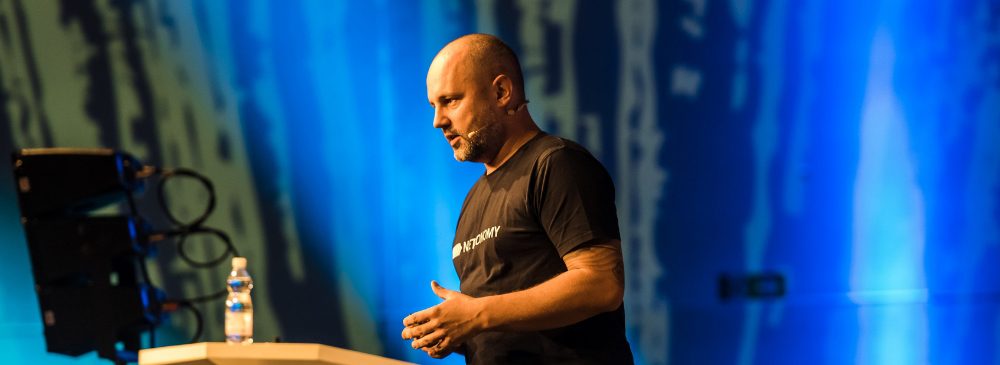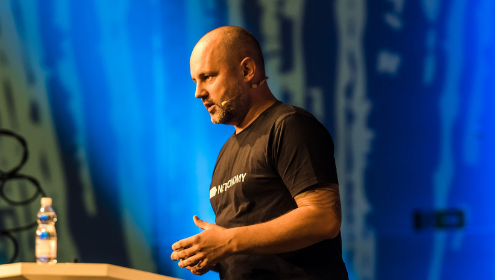
Focus on the Outcome, and Let the People Find Their Way to Achieve It | Martin Bachler on Distributed Projects and Remote Collaboration Best Practices

Day after day, we’re seeing how the current public health emergency is affecting communities and companies on a global scale. Definitely, an economic crisis is inevitable – the UN currently estimates 25 million jobs to be lost, and some other predictions go even higher. On the other hand, companies with a digital-first strategy are experiencing increased demand and even adding jobs. Amazon announced the hiring of 100.000 people in the US to keep up with a big spike in online shopping, Zoom Video Communications is forecasting a 64% year-over-year revenue growth in the first quarter. Companies are forced to change the business models, the mindsets and the way they operate on a daily basis.
We’re lucky to live in a time where the internet and technology give us many more possibilities than before. For us at NETCONOMY, distributed projects are a norm, as we are a team of 450 people spread across 10 locations. In fact, the day after we all switched to the home office, we celebrated a successful go-live of one of our projects. Here are some thoughts and useful tips regarding distributed projects from our CTO, Martin Bachler, all based on years of experience and our lessons learned.
Distributed collaboration is nothing new to us. How many locations are normally involved in NETCONOMY projects? How often do the colleagues from different locations meet in person?
On average our teams are distributed across three locations. There are also bigger projects in which it’s up to five locations. However, when we speak about team distribution, the most important thing to keep in mind is that it actually doesn’t matter if it’s two or five locations. As soon as there are people working from two locations, you need to treat it as it is fully distributed. There is no difference and you have to provide a reliable set of tools and proper communication in any case. In the beginning, there is usually a kickoff meeting in person, when people get to know each other and do the planning. Then, depending on the project, they meet every 1-2 months… on average, let’s say every six weeks. We also pay attention to have a balanced team distribution. For example, having a team of 20 people on one location, and two people on the other is not a good setup – those two people will always feel excluded or less important. Apart from skills and experience, this is another thing we take into consideration when forming our teams.
Which tools for distributed collaboration and remote project management are used at NETCONOMY?
The main tools we are using for communication are Zoom and Slack. We also have Confluence and Jira which are very important for content sharing, knowledge base building, and project management in general. I must mention that it’s not only important to get and introduce the right tools. You must keep the entire team updated on the changes in guidelines for when and how to use them. This way you will avoid miscommunication, posting the same things several times, etc.
Tools are simply something we buy, get trained on, and follow the rules on how to use. What about some concepts or processes developed internally?
Over time we have established internal groups of people, so-called “clans”, which are interested in certain topics and develop their knowledge in these specific areas. We have a “Distributed Collaboration Clan” – a team that stays on top of the latest trends in remote work and distributed project management. They gather relevant information, try out new things and then roll them out to the entire company when it makes sense. We are very happy to have this way of continuous learning initiatives established at NETCONOMY. In the case of the current crisis, it turned out to be extremely useful to invest time and effort in these activities upfront.
Introducing appropriate tools and processes is, of course, a must for companies starting with distributed project management. But even when having those in place, some companies still don’t believe the productivity won’t be affected. There is a “soft” barrier that not everyone wants to communicate – the issue of having trust. How to overcome that?
The thing is, it doesn’t really matter if a team is distributed, working from the same location or everyone is in the home office. In the agile approach, you really have to trust the people and hold them accountable not for the way they work, but for the result to which they have committed. That’s even more important in the case of the home office. Of course, you have to track usual indicators that you would track anyway, but at the end of the day, it’s the result to which the team has committed to that matters. In our case – we don’t see any bump or a downside trend when people are working from home. It’s not about the way they achieve the goal but that they do achieve it.
It’s not only about ensuring that the company’s goals are achieved. What about the wellbeing of employees?
Now when everyone is at home and there is no bumping into each other at the hall, no quick chats or coffee breaks with the colleagues – it’s important to support things like these virtually. We have virtual coffee corners for every office location, there are remote yoga classes and our location managers do a weekly check-in with all the employees. Last week we launched a Qualtrics survey to gather employee feedback. In this process, we truly trust our colleagues and rely on them to tell us how they feel and what else they need. When you are all in one location, you can always stop by at any office to say hi and quickly understand the current mood, which is equally important as formal meetings. During the time of limited face-to-face communication, you must find a virtual way to do that.
The crisis is forcing companies to adjust and sometimes make unexpected decisions. Can you also see some positive changes as an outcome of this entire situation?
There are some a bit more conservative companies and the ones who would normally say that they will never be able to control people when working from home. The positive side of this situation is that they are forced to make an adjustment now, and they will see that it works. If you check your indicators, you may realize that nothing changed. This could be a chance to change their internal procedures and allow home office after the crisis as well – there could be a positive effect if they give it a try. It’s not about giving people a break, but just allowing more flexibility which then directly affects productivity too.
Can you point out any special learnings, things you didn’t expect to happen during the years when it comes to distributed projects?
I can’t really mention one single highlight, but what I can definitely say is that people always surprise you with their creativity and the ability to find new solutions quickly. Our colleagues have always been proactive and willing to go ahead, try out new approaches and then propose that to the team. That’s kind of an added value to this entire process – the continuous that comes from trying out new things.
Let’s say there is a company that theoretically can but doesn’t yet have an option of remote work. What would be the most important points to consider when introducing this possibility?
1. Define what your goal is and how you measure how far you are from reaching it. Just being in the office and working for 8h doesn’t tell you anything – you need to have KPIs that really work and reflect on your definition of success.
2. Don’t start with everyone working from home, but rather do it step-by-step. Normally more senior people need more flexibility. A good approach could be to define a certain team, or a set of roles, or seniority, to get this possibility first. Then see how it goes and rollout to others step by step.
3. It’s very important to ask people what they need, and not just tell them what they should do. You may have one tool that should do the work, but in reality, it fails. Let your people tell you what happens on a daily basis and adjust to that.
4. Last but not least, the mindset really matters. It doesn’t matter where people sit but what the outcome is. Without trust, there won’t be any remote collaboration.



